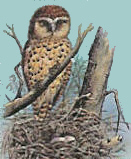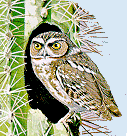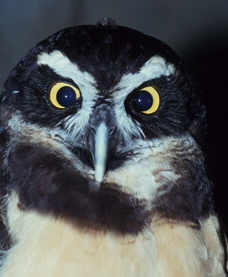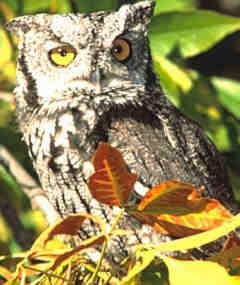PEL'S FISHING OWL (Scotopelia peli)
 A
huge impressive owl, considered on of the largest owls in the world. Fishing owls are found in Asia and Africa.
Like other owls, the Asian owls have ear-like tufts of feathers on their
heads, but the African fishing owls do not. All fishing owls have
extra long powerful toes armed with strong claws, the undersides of their
toes have pointed, spiky scales. As they catch fish by flying low
over the water and seizing the prey with their feet, these scales give
even a slippery fish little chance of escape. The Pel's fishing
owl is the most common African fishing owl, and lives near wide rivers.
It hunts at night, when its huge-fronted eyes let in light and they are
able to see clearly even by starlight. They have loud, resonant calls
which consist of either repeated short hoots, or a much longer, deep booming
call. By day, they usually roost in the trees. In the early
evening, they often sit on rocky crags, watching the river below for fish.
A
huge impressive owl, considered on of the largest owls in the world. Fishing owls are found in Asia and Africa.
Like other owls, the Asian owls have ear-like tufts of feathers on their
heads, but the African fishing owls do not. All fishing owls have
extra long powerful toes armed with strong claws, the undersides of their
toes have pointed, spiky scales. As they catch fish by flying low
over the water and seizing the prey with their feet, these scales give
even a slippery fish little chance of escape. The Pel's fishing
owl is the most common African fishing owl, and lives near wide rivers.
It hunts at night, when its huge-fronted eyes let in light and they are
able to see clearly even by starlight. They have loud, resonant calls
which consist of either repeated short hoots, or a much longer, deep booming
call. By day, they usually roost in the trees. In the early
evening, they often sit on rocky crags, watching the river below for fish.
ELF OWL (Micrathene whitneyi)
 The Elf owl is also called Whitney's owl after
its discoverer. It has yellow eyes and is buff colored with dark
streaks. Their egg are white. It has a round head with no ear tuft, a chunky body
and short tail. It is one of the smallest owls in the world raining
in size from 8-10 cm) and weighs only 1.5 ounces. This particular species of owl is found only in the
dry parts of the southwest United States and in Mexico, where it is also
known as the cactus owl. Elf owls frequently make their nests in
the trunks of candelabra cactus trees.
The Elf owl is also called Whitney's owl after
its discoverer. It has yellow eyes and is buff colored with dark
streaks. Their egg are white. It has a round head with no ear tuft, a chunky body
and short tail. It is one of the smallest owls in the world raining
in size from 8-10 cm) and weighs only 1.5 ounces. This particular species of owl is found only in the
dry parts of the southwest United States and in Mexico, where it is also
known as the cactus owl. Elf owls frequently make their nests in
the trunks of candelabra cactus trees.
The elf owl is more thoroughly nocturnal than
most other species of small owls, usually spending the entire day in hiding.
It is primarily an insect-feeder, consisting largely on night flying moths
and locusts, skillfully caught while the insects are on its wing.
It also catches the odd lizard. Its hooting is very loud for a bird
of its size and can be heard a long way off.
SPECTACLED OWL (Pulsatrix perspicillata)
 Spectacled owls live in the densely warm, damp
tropical rain forests of South America. Here the trees have long
trunks devoid of leaves, and all the leaves are at the top of the tree,
forming a thick green canopy which stops the sunlight from reaching the
forest floor.
Spectacled owls live in the densely warm, damp
tropical rain forests of South America. Here the trees have long
trunks devoid of leaves, and all the leaves are at the top of the tree,
forming a thick green canopy which stops the sunlight from reaching the
forest floor.
This owl feeds on small mammals, such as baby
squirrel monkeys, marmosets, squirrels, and mice and on insects such as
dragonflies, butterflies, and moths. Although most owls are nocturnal,
the Spectacled owl will hunt in the dim light under the canopy during the
day.
SCOPS OWL (Otus scops)
 A Scops owl or Screech owl is rather a mysterious
bird that has a long slim body and speckled plumage which can trick the
observer into thinking it is just a withered tree stump. This small
owl is migratory. These owls live throughout the world, but this variety
is from the Mediterranean. This species likes orchards
especially olive groves. In mountain areas
it occurs up to 4,000 feet but not beyond because it is too chilly.
The monotonous song, a series of hoots emitted at brief intervals, is performed
by the male.
A Scops owl or Screech owl is rather a mysterious
bird that has a long slim body and speckled plumage which can trick the
observer into thinking it is just a withered tree stump. This small
owl is migratory. These owls live throughout the world, but this variety
is from the Mediterranean. This species likes orchards
especially olive groves. In mountain areas
it occurs up to 4,000 feet but not beyond because it is too chilly.
The monotonous song, a series of hoots emitted at brief intervals, is performed
by the male.
Like most owls, the Scops rest during the day
and starts hunting at dusk. It is primarily a hunter of insects,
especially big insects such as hawk moths, and streaks through the air in
pursuit of them. It is sometimes seen perched near street lighting,
waiting for insects. It supplements this diet with rodents and small
birds.